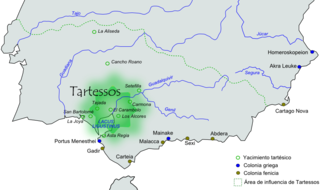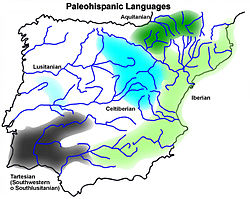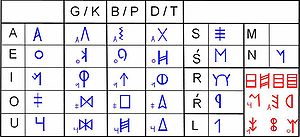| Tartessian | |
|---|---|
| Region | Southwest Iberian Peninsula |
| Extinct | after 5th century BC |
| Southwest Paleohispanic | |
| Language codes | |
| ISO 639-3 | txr |
txr | |
| Glottolog | tart1237 |
 Approximate extension of the area under Tartessian influence | |

The Tartessian language is the extinct Paleohispanic language of inscriptions in the Southwestern script found in the southwest of the Iberian Peninsula: mainly in the south of Portugal (Algarve and southern Alentejo), and the southwest of Spain (south of Extremadura and western Andalusia). There are 95 of these inscriptions, the longest having 82 readable signs. Around one-third of them were found in Early Iron Age necropolises or other Iron Age burial sites associated with rich complex burials. It is usual to date them to the 7th century BC and consider the southwestern script to be the most ancient Paleohispanic script, with characters most closely resembling specific Phoenician letter forms found in inscriptions dated to c. 825 BC. Five of the inscriptions occur on stelae with what has been interpreted as Late Bronze Age carved warrior gear from the Urnfield culture.[1]
Name
Most researchers use the term Tartessian to refer to the language as attested on the stelae written in the Southwestern script,[2] but some researchers would prefer to reserve the term Tartessian for the language of the core Tartessian zone, attested for these researchers with some archaeological graffiti[3] – like the Huelva graffito[4] – and maybe with some stelae:[5] for example, Villamanrique de la Condesa (J.52.1).[6] These researchers consider that the language of the inscriptions found outside the core Tartessian zone would be either a different language[7] or maybe a Tartessian dialect,[8] and so they would prefer to identify the language of the stelae with a different title, namely "southwestern"[9] or "south-Lusitanian".[10] There is general agreement that the core area of Tartessos is around Huelva, extending to the valley of the Guadalquivir, while the area under Tartessian influence is much wider[11] (see maps). Three of the 95 stelae, plus some graffiti, belong to the core area: Alcala del Rio (Untermann J.53.1), Villamanrique de la Condesa (J.52.1) and Puente Genil (J.51.1). Four have also been found in the Middle Guadiana (in Extremadura), and the rest have been found in the south of Portugal (Algarve and Lower Alentejo), where the Greek and Roman sources locate the pre-Roman Cempsi and Sefes, Cynetes, and Celtici peoples.
History
The most confident dating is for the Tartessian inscription (J.57.1) in the necropolis at Medellin, Badajoz, Spain to 650/625 BC.[12] Further confirmatory dates for the Medellin necropolis include painted ceramics of the 7th–6th centuries BC.[13]
In addition a graffito on a Phoenician sherd dated to the early to mid 7th century BC and found at the Phoenician settlement of Doña Blanca near Cadiz has been identified as Tartessian by the shape of the signs. It is only two signs long, reading ]tetu[ or perhaps ]tute[. It does not show the syllable-vowel redundancy more characteristic of the southwestern script, but it is possible that this developed as indigenous scribes adapted the script from archaic Phoenician and other such exceptions occur (Correa and Zamora 2008).
The script used in the mint of Salacia (Alcácer do Sal, Portugal) from around 200 BC may be related to the Tartessian script, though it has no syllable-vowel redundancy; violations of this are known, but it is not clear if the language of this mint corresponds with the language of the stelae (de Hoz 2010).
The Turdetani of the Roman period are generally considered the heirs of the Tartessian culture. Strabo mentions that: "The Turdetanians are ranked as the wisest of the Iberians; and they make use of an alphabet, and possess records of their ancient history, poems, and laws written in verse that are six thousand years old, as they assert."[14] It is not known when Tartessian ceased to be spoken, but Strabo (writing c. 7 BC) records that "The Turdetanians ... and particularly those that live about the Baetis, have completely changed over to the Roman mode of life, not even remembering their own language any more."[15]
Writing

Tartessian inscriptions are in the Southwestern script, also known as the Tartessian or South Lusitanian script. Like all the paleohispanic scripts, with the exception of the Greco-Iberian alphabet, Tartessian uses syllabic glyphs for plosive consonants and alphabetic letters for other consonants. Thus it is a mixture of an alphabet and a syllabary, a system called a semi-syllabary. Some researchers believe these scripts are descended solely from the Phoenician alphabet, others that the Greek alphabet had an influence as well.
The Tartessian script is very similar to the southeastern Iberian script, both in the shapes of the signs and in their values. The main difference is that southeastern Iberian script does not redundantly mark the vocalic values of syllabic characters. This was discovered by Ulrich Schmoll and allows the classification of most of the characters into vowels, consonants and syllabic characters. As of the 1990s, the decipherment of the script was largely complete, thus the sound values of most of the characters are known.[16][17] Like most other paleohispanic scripts, Tartessian did not distinguish between voiced and unvoiced consonants—[t] from [d], [p] from [b], or [k] from [ɡ].[18]
Tartessian is written in scriptio continua, making the identification of individual words difficult.
Classification
Tartessian is generally left unclassified, due to lack of data, or proposed to be a language isolate due to an absence of connections to the Indo-European languages.[19][20] Some Tartessian names have been interpreted as Indo-European or more specifically as Celtic.[21] However, the language as a whole remains inexplicable from the Celtic or Indo-European point of view; the structure of Tartessian syllables appears to be incompatible with Celtic or even Indo-European phonetics, and more compatible with Iberian or Basque; any Celtic elements are thought to be borrowings by some scholars.[22]
Since 2009, John T. Koch has argued that Tartessian is a Celtic language and that the texts can be translated.[23][24][25][26] Koch's thesis has been popularised by the BBC TV series The Celts[27] and the associated book by Alice Roberts.[28] However, his proposals have been regarded with scepticism by academic linguists and the script, which is "hardly suitable for the denotation of an Indo-European language[,] leaves ample room for interpretation."[29]
Texts


Examples from the Tartessian inscriptions (Untermann's numbering system or location name if newer in brackets references the inscriptions in the examples, e.g. (J.19.1) or (Mesas do Castelinho)); transliteration is Rodríguez Ramos (2000):
- Mesas do Castelinho (Almodôvar)
- Longest Tartessian text known at present, with 82 signs, 80 of which have an identifiable phonetic value. The text is complete given the substitution of the known Tartessian formula bᵃare naŕkᵉe[n—] in the damaged portion (Guerra 2009):
- tᶤilekᵘuṟkᵘuarkᵃastᵃaḇᵘutᵉebᵃantᶤilebᵒoiirerobᵃarenaŕḵᵉ[en?]aφiuu
- lii*eianiitᵃa
- eanirakᵃaltᵉetᵃao
- bᵉesaru[?]an
Note: The reading [en?] in the damaged portion is assumed from the Tartessian formula bᵃare naŕkᵉe[n—]. This formula contains two groups of Tartessian stems that appear to inflect as verbs: naŕkᵉe, naŕkᵉen, naŕkᵉeii, naŕkᵉenii, naŕkᵉentᶤi, naŕkᵉenai and bᵃare, bᵃaren, bᵃareii, bᵃarentᶤi from comparison with other inscriptions. (Guerra 2009)
- Fonte Velha (Bensafrim) (J.53.1)
- lokᵒobᵒoniirabᵒotᵒoaŕaiaikᵃaltᵉelokᵒonanenaŕ[–]ekᵃa[?]ᶤiśiinkᵒolobᵒoiitᵉerobᵃarebᵉetᵉasiioonii (Untermann 1997)
- Herdade da Abobada (Almodôvar) (J.12.1)
- iŕualkᵘusielnaŕkᵉentᶤimubᵃatᵉerobᵃare[?]ᵃatᵃaneatᵉe (Untermann 1997)
See also
- Arganthonios
- Celtiberian language
- Gallaecian language
- Hispano-Celtic languages
- Pre-Roman peoples of the Iberian Peninsula
- Continental Celtic languages
References
- ^ Koch, John T. (2013). Celtic from the West 2 - Prologue: The Earliest Hallstatt Iron Age cannot equal Proto-Celtic. Oxford: Oxbow Books. pp. 10–11. ISBN 978-1-84217-529-3.
- ^ Untermann 1997, Koch 2009-2012, Villar 2004-2012, Yocum 2012, &c.
- ^ Correa 2009, p. 277; de Hoz 2007, p. 33; 2010, pp. 362–364.
- ^ Untermann 1997, pp. 102–103; Mederos and Ruiz 2001.
- ^ Correa 2009, p. 276.
- ^ Catalogue numbers for inscriptions refer to Jürgen Untermann, ed. (1997): Monumenta Linguarum Hispanicarum. IV Die tartessischen, keltiberischen und lusitanischen Inschriften; unter Mitwirkungen von Dagmar Wodtko. Wiesbaden: Ludwig Reichert.
- ^ Villar 2000, p. 423; Rodríguez Ramos 2009, p. 8; de Hoz 2010, p. 473.
- ^ Correa 2009, p. 278.
- ^ Villar 2000; de Hoz 2010.
- ^ Rodríguez Ramos 2009
- ^ Koch 2010 2011
- ^ Almagro-Gorbea, M (2004). "Inscripciones y grafitos tartesicos de la necropolis orientalizante de Medellin". Palaeohispanica: 4.13–44.
- ^ Ruiz, M M (1989). "Las necropolis tartesicas: prestigio, poder y jerarquas". Tartessos: Arqueologica Protohistorica del Bajo Guadalquivir: 269.
- ^ Strabo, Geography, book 3, chapter 1, section 6.
- ^ Strabo, Geography, book 3, chapter 2, section 15.
- ^ Untermann, Jürgen (1995). "Zum Stand der Deutung der "tartessischen" Inschriften". Hispano- Gallo-Brittonica: essays in honour of Professor D. Ellis Evans on the occasion of his sixty-fifth birthday. Cardiff: University of Wales Press. pp. 244–59.
- ^ Untermann, J., ed. (1997). Monumenta Linguarum Hispanicarum; herausgegeben von Jürgen Untermann; unter Mitwirkungen von Dagmar Wodtko. Band IV, Die tartessischen, keltiberischen und lusitanischen Inschriften. Wiesbaden: Ludwig Reichert.
((cite book)):|first=has generic name (help)CS1 maint: multiple names: authors list (link) - ^ "O'Donnell Lecture 2008 Appendix" (PDF).
- ^ Rodríguez Ramos (2002)
- ^ de Hoz (2010)
- ^ (Correa 1989, Untermann 1997)
- ^ (Rodríguez Ramos 2002, de Hoz 2010)
- ^ Koch, John T (2009). Tartessian. Celtic in the South-West at the Dawn of History. Celtic Studies Publications, Aberystwyth. ISBN 978-1-891271-17-5.
- ^ Koch, John T (2011). Tartessian 2: The Inscription of Mesas do Castelinho ro and the Verbal Complex. Preliminaries to Historical Phonology. Celtic Studies Publications, Aberystwyth. pp. 1–198. ISBN 978-1-907029-07-3.
- ^ Villar, Prósper, Jordán, Pilar Fernández Álvarez, F., B. Ma., C., Ma. (2011). Lenguas, genes y culturas en la prehistoria de Europa y Asia suroccidental. Ediciones Universidad de Salamanca,Salamanca. p. 100. ISBN 978-84-7800-135-4.
((cite book)): CS1 maint: multiple names: authors list (link) - ^ Koch, John T. "Common Ground and Progress on the Celtic of the South-western SW Inscriptions". Academia.edu. Retrieved 3 March 2017.
- ^ "The Celts: Blood, Iron and Sacrifice". BBC. Retrieved 2015-10-09.
- ^ Roberts, Alice (2015). The Celts: Search for a Civilisation. Heron Books. ISBN 1784293326.
- ^ Zeidler, Jürgen (2011). "Barry W. Cunliffe, John T. Koch (ed.), Celtic from the West: Alternative Perspectives from Archaeology, Genetics, Language, and Literature. Celtic Studies Publications 15. Oxford/ Oakville, CT: Oxbow Books, 2010. Pp. vii, 384. ISBN 978-1-84217-410-4". Bryn Mawr Classical Review.
Further reading
- Ballester, Xaverio (2004): «Hablas indoeuropeas y anindoeuropeas en la Hispania prerromana», Estudios de lenguas y epigrafía antiguas – ELEA 6, pp. 107–138.
- Broderick, George (2010): «Das Handbuch der Eurolinguistik», Die vorrömischen Sprachen auf der iberischen Halbinsel, ISBN 3-447-05928-1, pp. 304–305
- Correa, José Antonio (1989): «Posibles antropónimos en las inscripciones en escritura del S.O. (o Tartesia)», Veleia; 6, pp. 243–252.
- Correa, José Antonio (1992): «La epigrafía tartesia», Andalusien zwischen Vorgeshichte und Mittelalter, eds. D. Hertel & J. Untermann, pp. 75–114.
- Correa, José Antonio (1995): «Reflexiones sobre la epigrafía paleohispánica del suroeste de la Península Ibérica», Tartessos 25 años después, pp. 609–618.
- Correa, José Antonio (2009): «Identidad, cultura y territorio en la Andalucía prerromana a través de la lengua y la epigrafía», Identidades, culturas y territorios en la Andalucía prerromana, eds. F. Wulff Alonso & M. Álvarez Martí-Aguilar, Málaga, pp. 273–295.
- Correa, José Antonio, Zamora, José Ángel (2008): «Un graffito tartessio hallado en el yacimiento del Castillo do Dona Blanca», Palaeohispanica 8, pp. 179–196.
- Correia, Virgílio-Hipólito (1996): «A escrita pré-romana do Sudoeste peninsular», De Ulisses a Viriato: o primeiro milenio a.c., pp. 88–94.
- Eska, Joseph (2013): Review: "John T. Koch, Barry W. Cunliffe (ed.), Celtic from the West 2: Rethinking the Bronze Age and the Arrival of Indo-European in Atlantic Europe. Celtic studies publications, 16. Oxford; Oakville, CT: Oxbow Books, 2013". Bryn Mawr Classical Review 2013.12.35.
- Eska, Joseph (2014): «Comments on John T. Koch’s Tartessian-as-Celtic Enterprise», Journal of Indo-European Studies 42/3-4, pp. 428–438.
- Gorrochategui, Joaquín (2013): “Hispania Indoeuropea y no Indoeuropea”, in Iberia e Sardegna: Legami linguistici, archeologici e genetici dal Mesolitico all’Età del Bronzo - Proceedings of the International Congress «Gorosti U5b3» (Cagliari-Alghero, June 12–16, 2012), pp. 47–64.
- Guerra, Amilcar (2002): «Novos monumentos epigrafados com escrita do Sudoeste da vertente setentrional da Serra do Caldeirão», Revista Portuguesa de arqueologia 5-2, pp. 219–231.
- Guerra, Amilcar (2009): «Novidades no âmbito da epigrafia pré-romana do sudoeste hispânico» in Acta Palaeohispanica X, Palaeohispanica 9, pp. 323–338.
- Guerra, Amilcar (2013): “Algumas questões sobre as escritas pré-romanas do Sudoeste Hispánico”, in Acta Palaeohispanica XI: Actas del XI coloquio internacional de lenguas y culturas prerromanas de la Península Ibérica (Valencia, 24-27 de octubre de 2012) (Palaeohispanica 13), pp. 323–345.
- Hoz, Javier de (1995): «Tartesio, fenicio y céltico, 25 años después», Tartessos 25 años después, pp. 591–607.
- Hoz, Javier de (2007): «Cerámica y epigrafía paleohispánica de fecha prerromana», Archivo Español de Arqueología 80, pp. 29–42.
- Hoz, Javier de (2010): Historia lingüística de la Península Ibérica en la antigüedad: I. Preliminares y mundo meridional prerromano, Madrid, CSIC, coll. « Manuales y anejos de Emerita » (ISBN 978-84-00-09260-3, ISBN 978-84-00-09276-4).
- Koch, John T. (2010): «Celtic from the West Chapter 9: Paradigm Shift? Interpreting Tartessian as Celtic»[permanent dead link], Oxbow Books, Oxford, ISBN 978-1-84217-410-4 pp. 187–295.
- Koch, John T. (2011): «Tartessian 2: The Inscription of Mesas do Castelinho ro and the Verbal Complex. Preliminaries to Historical Phonology», Oxbow Books, Oxford, ISBN 978-1-907029-07-3 pp. 1–198.
- Koch, John T. (2011): «The South-Western (SW) Inscriptions and the Tartessos of Archaeology of History», Tarteso, El emporio del Metal, Huelva.
- Koch, John T. (2013): «Celtic from the West 2 Chapter 4: Out of the Flow and Ebb of the European Bronze Age: Heroes, Tartessos, and Celtic», Oxbow Books, Oxford, ISBN 978-1-84217-529-3 pp. 101–146.
- Koch, John T. (2014a): «On the Debate over the Classification of the Language of the South-Western (SW) Inscriptions, also known as Tartessian», Journal of Indo-European Studies 42/3-4, pp. 335–427.
- Koch, John T. (2014b): «A Decipherment Interrupted: Proceeding from Valério, Eska, and Prósper», Journal of Indo-European Studies 42/3-4, pp. 487–524.
- Mederos, Alfredo; Ruiz, Luis (2001): «Los inicios de la escritura en la Península ibérica. Grafitos en cerámicas del bronce final III y fenicias»[permanent dead link], Complutum 12, pp. 97–112.
- Mikhailova, T. A. (2010) Review: "J.T. Koch. Tartessian: Celtic in the South-West at the Dawn of history (Celtic Studies Publication XIII). Aberystwyth: Centre for advanced Welsh and Celtic studies, 2009" Вопросы языкознания 2010 №3; 140-155.
- Prósper, Blanca M. (2014): "Some Observations on the Classification of Tartessian as a Celtic Language". Journal of Indo-European Studies 42/3-4, pp. 468–486.
- Rodríguez Ramos, Jesús (2000): “La lectura de las inscripciones sudlusitano-tartesias”. Faventia 22/1, pp 21–48.
- Rodríguez Ramos, Jesús (2002a): “El origen de la escritura sudlusitano-tartesia y la formación de alfabetos a partir de alefatos”. Rivista di Studi Fenici 30/2, pp. 187–216.
- Rodríguez Ramos, Jesús (2002b): "Las inscripciones sudlusitano-tartesias: su función, lingua y contexto socioeconómico". Complutum 13, pp. 85–95.
- Rodríguez Ramos, Jesús (2009): «La lengua sudlusitana», Studia Indogermanica Lodziensia VI, pp. 83–98.
- Untermann, Jürgen, ed. (1997): Monumenta Linguarum Hispanicarum. IV Die tartessischen, keltiberischen und lusitanischen Inschriften; unter Mitwirkungen von Dagmar Wodtko. Wiesbaden: Ludwig Reichert.
- Valério, Miguel (2008 [2009]): “Origin and Development of the Paleohispanic scripts: The Orthography and Phonology of the Southwestern Alphabet". Revista Portuguesa de Arqueologia 11-2, pp. 107–138. [1]
- Valério, Miguel (2014): "The Interpretative Limits of the Southwestern Script". Journal of Indo-European Studies 42/3-4, pp. 439–467.
- Untermann, Jürgen (2000): «Lenguas y escrituras en torno a Tartessos» en ARGANTONIO. Rey de Tartessos, Madrid, pp. 69–77.
- Villar, Francisco (2000): Indoeuropeos y no indoeuropeos en la Hispania prerromana, Ediciones Universidad de Salamanca (ISBN 978-84-78-00968-8).
- Villar, Francisco (2004): «The Celtic Language of the Iberian Peninsula», Studies in Baltic and Indo-European Linguistics in Honor of William R. Schmalstieg pp. 243–274.
- Wikander, Stig (1966): «Sur la langue des inscriptions Sud-Hispaniques», in Studia Linguistica 20, 1966, pp. 1–8.